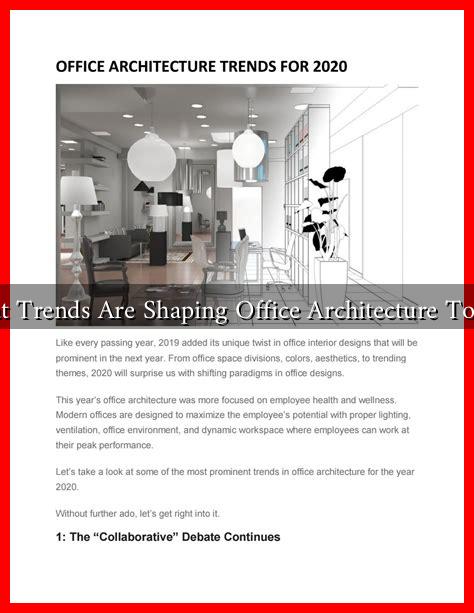-
Table of Contents
What Trends Are Shaping Office Architecture Today?
As the world of work continues to evolve, so too does the architecture of office spaces. The traditional cubicle-filled office is becoming a relic of the past, replaced by innovative designs that prioritize flexibility, sustainability, and employee well-being. This article explores the key trends shaping office architecture today, providing insights into how these changes are influencing the way we work.
The Rise of Flexible Workspaces
One of the most significant trends in office architecture is the shift towards flexible workspaces. With the rise of remote work and hybrid models, companies are rethinking their office layouts to accommodate a variety of work styles. Flexible workspaces can include:
- Hot Desking: Employees do not have assigned desks, allowing them to choose where they work each day.
- Collaboration Zones: Open areas designed for teamwork and brainstorming sessions.
- Quiet Spaces: Designated areas for focused work, minimizing distractions.
For example, companies like WeWork have popularized the concept of shared office spaces, allowing businesses to rent flexible work environments that can adapt to their needs. According to a report by JLL, 30% of office space is expected to be flexible by 2030, highlighting the growing demand for adaptable work environments.
Sustainability and Green Design
As environmental concerns become increasingly pressing, sustainability is a key focus in modern office architecture. Architects and designers are incorporating eco-friendly materials and energy-efficient systems to create greener workplaces. Key elements of sustainable office design include:
- Energy-Efficient Systems: Utilizing smart technology to optimize energy use.
- Natural Materials: Incorporating wood, bamboo, and recycled materials into construction.
- Green Roofs and Walls: Adding vegetation to improve air quality and reduce heat.
One notable example is the Bullitt Center in Seattle, often referred to as the “greenest commercial building in the world.” It features solar panels, rainwater harvesting, and composting toilets, showcasing how sustainable design can be both functional and aesthetically pleasing.
Emphasis on Employee Well-Being
Modern office architecture is increasingly focused on enhancing employee well-being. This trend recognizes that a healthy work environment can lead to increased productivity and job satisfaction. Key design elements that promote well-being include:
- Natural Light: Maximizing windows and skylights to improve mood and energy levels.
- Biophilic Design: Integrating nature into the workspace through plants and natural materials.
- Ergonomic Furniture: Providing adjustable desks and comfortable seating to reduce physical strain.
Research from the World Green Building Council indicates that well-designed workspaces can increase productivity by up to 15%. Companies like Google and Facebook have embraced these principles, creating environments that prioritize employee health and happiness.
Technology Integration
As technology continues to advance, its integration into office architecture is becoming more prevalent. Smart buildings equipped with IoT (Internet of Things) devices can enhance the workplace experience by:
- Automating Lighting and Climate Control: Adjusting settings based on occupancy and preferences.
- Enhancing Security: Utilizing biometric access and surveillance systems.
- Facilitating Remote Collaboration: Incorporating advanced video conferencing tools and virtual reality spaces.
For instance, the Edge in Amsterdam is known for its cutting-edge technology, featuring an app that allows employees to control their environment and book meeting rooms seamlessly.
Conclusion
The trends shaping office architecture today reflect a broader shift towards flexibility, sustainability, and employee well-being. As companies adapt to the changing landscape of work, architects and designers are tasked with creating spaces that not only meet functional needs but also enhance the overall work experience. By embracing these trends, businesses can foster a more productive, engaged, and satisfied workforce.
In summary, the future of office architecture is bright, driven by innovative designs that prioritize adaptability, environmental responsibility, and the health of employees. As we move forward, these trends will continue to redefine how we think about and utilize office spaces.
For more insights on office design trends, visit Architectural Digest.

